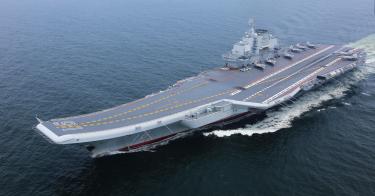Since 2012, when China commissioned its first aircraft carrier, carrier modernization and operational experimentation have advanced at a frighteningly fast pace. Today, the People’s Liberation Army Navy (PLAN) is capable of conducting high-intensity operations near its shores and low-intensity missions across the globe.
That progress was on full display a few weeks ago when the PLAN carried out its first distant multi-aircraft carrier operations. The aircraft carrier Liaoning was seen by Japan’s Self Defense Forces operating southwest of Minamitori Island, marking the first time a Chinese carrier has ventured beyond the second island chain.
The Liaoning, along with the Shandong, were deployed for “far-sea combat-oriented training” in the high seas. Both vessels were spotted entering the Western Pacific at separate locations before engaging in joint operations.
The latest moves are part of China’s broader “blue-water navy” strategy, extending naval aviation operations beyond the safety of land bases. They signal growing proficiency in sustaining multi-carrier flight operations with limited logistical support.
While not the first time that PRC forces have crossed beyond the second island chain, it is the first time that aircraft carriers have operated this far. This development is consequential: Aircraft carriers are considered the most valuable sea-based assets and the pinnacle expression of a nation’s naval diplomacy.
Aircraft carriers essentially function as floating air bases capable of coordinating vessel-aircraft operations. They can conduct extensive Air Interdiction, Anti-Surface Warfare, and offensive and defensive Counter-Air operations.
Recent PLA doctrinal writing emphasizes the importance of system-to-system competition, or the idea that victory in conflict depends on outperforming integrated systems of adversaries. In this highly informatized form of warfare, victory hinges upon the operational success of command posts.
The Liaoning, hailed by Chinese state media as the “benchmark force,” has assumed central roles as at-sea command centers and currently hosts the PLAN’s “Aircraft Carrier 1st Task group Command Post.” In 2018, the Liaoning’scommand center was upgraded with extensive communications features.
These capabilities enable communication to the Liaoning’s 40 aircraft, including 24 Shenyang J-15 fighter jets, 6 Changhe Z-18F anti-submarine helicopters, 4 Changhe Z-18J airborne early warning helicopters, and 2 Harbin Z-9C rescue helicopters. The Shandong can carry up to 50 J-15 fighters.
In this last deployment, both vessels carried out a series of drills, including reconnaissance, air defense, counterstrikes, under “combat conditions.” Japan’s Defense Ministry confirmed close to 520 take-offs and landings across both vessels.
While these activities underscore China’s growing naval reach, they remain within the bounds of international law. Large swathes of the Pacific Ocean are considered international waters where no single nation has sovereignty. The UN Convention on the Law of the Sea establishes the right to navigate international waters without interference.
For the time being, China’s carriers remain behind the U.S. in both size and capability.
According to a comprehensive assessment by the Center for Strategic and International Studies, the Liaoning lags behind U.S. carriers in part due to its less efficient power plant and underpowered aircraft-launching system. Its size is smaller than the U.S. Nimitz-class carrier USS Ronald Reagan currently stationed in Japan and far short of the Reagan’s fixed-wing capacity.
>>> America Needs a “China Tech Power Report” To Fight the New Cold War
Nonetheless, the Liaoning and Shandong’s extending reach demonstrates the PLAN’s rapid modernization. It marks yet another step in Beijing’s effort to reshape the balance of power in the Indo-Pacific.
If China were able to stall or disrupt U.S. naval forces beyond the second island chain, it could seriously complicate combat operations necessary to thwart a Chinese invasion or blockade of Taiwan.
Reinforcing Taiwan would become significantly more difficult and costly, as carrier strike groups and logistics convoys would have to traverse contested waters under threat from Chinese anti-access and area denial systems.
As the threat landscape evolves, Washington must sustain a robust naval presence around the second island chain to counter China’s growing naval presence.
One way to do so is by enhancing the existing 12 ship-rider agreements with Pacific Island nations—arrangements that authorize U.S. Coast Guard patrols under host-state oversight. These agreements could be expanded to support rotational deployments, establish regional maritime training centers, and in time, integrate with U.S. naval deployments. Such efforts would not only reinforce deterrence but also affirm America’s commitment to strategic resilience across the Pacific.
Mere presence alone is no longer enough. China’s carrier operations beyond the second island chain mark a turning point in Indo-Pacific security. To protect security interests, the U.S. must solidify an enduring posture, one built on operational readiness.
This piece originally appeared in Breaking Defense




